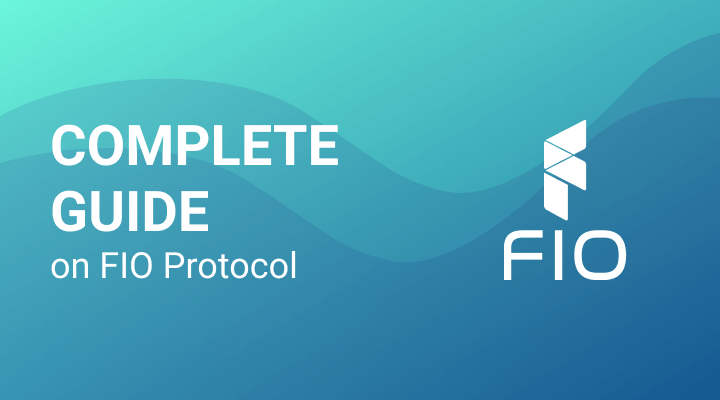Everyone who has interacted with crypto one way or another knows how daunting it can be – especially if they’re just beginning. This is due to the complexity of crypto transactions and the knowledge that your funds could be gone forever with a tiny mistake.
What if there was a seamless way that you could operate your account? What if you could interact with crypto using an everyday name instead of an intimidating public address?
Launched in April this year, FIO protocol (Foundation for Interwallet Interoperability) is an initiative that wants to make this possible. FIO says it wants to “make crypto products easier so anyone can use them.” It’s a platform that integrates exchanges, wallets, and more so people can have a better experience dealing with cryptocurrency. The FIO team believes the blockchain-based value wave is the inevitable future, and that “the masses are coming and we owe it to them to give them the experience they deserve.”
In this article, we’ll examine the FIO protocol from a closer vantage point. We’ll also look at the utility token of the protocol and what role it plays.
What Problem is FIO Hoping to Solve?
FIO’s vision for the blockchain space is based on actual research. The team conducted a survey in 2018 to establish the challenges that crypto users face – whether just operating their own account or sending money to others. They were then able to come up with the following feedback:
- Almost every user finds using public addresses such a hassle
- Almost 75% of users are uncomfortable or less than confident when sending crypto
- Nearly 1 in five users has conducted a failed transaction or one that led to the loss of funds
- 1 in 20 people has witnessed an attempted man-in-the-middle attack on their public address
The team then concluded that interacting with crypto generally is pretty stressful and requires a user to be extremely vigilant.
What are the Goals of the FIO Protocol?
The FIO team wants to create a better way for people everywhere to interact better with blockchain assets. This way encompasses several features, which are:
- Human-meaningful – enable users to interact with crypto using identifiers that are easy to understand and remember, e.g., “tom@trustwallet” or “alice@bitcoin”
- Decentralized – supported by a public blockchain that doesn’t rely on a centralized entity or third parties
- Secure – FIO transactions are conducted securely since they require an FIO non-custodial private key
- Private – sensitive information like transactions’ metadata and public addresses is cryptographically encrypted on the blockchain
- Interoperable – the FIO platform is capable of working with any blockchain crypto network once it’s integrated with any wallet
- eCommerce ready – the FIO protocol enables fast, safe, wallet-to-wallet and immutable payments with all metadata kept private
Features of FIO
The FIO protocol can support a variety of features – which we’ll look at below.
i) FIO Addresses – intelligible wallet identifiers such as tom@trustwallet” and “alice@bitcoin,” which are more friendly to use. With the addresses, users will not come across public addresses. The icing on the cake? The addresses can support any crypto in any wallet or exchange.
ii) FIO Requests – a functionality that allows users to request funds from any wallet via simple approvals. The requests are cryptographically secured and are only seen by the involved parties. FIO requests will not interfere with underlying blockchain transactions in any way
iii) FIO Data – this is encrypted metadata that can accompany transferred funds in transactions
These are just the current features of FIO. The network hopes to add more in the near future.
Technical Makeup of FIO
The FIO protocol utilizes delegated proof of stake (DPoS) for network consensus. Token holders are responsible for choosing block producers (BPs). Anyone can sign up to be a BP if they can garner enough votes. Every voting round is known as an epoch, and it involves the generation of 126 blocks. The BP selection process is repeated after every epoch – which involves 42 BPs – half active and a half on standby.
After each block is produced and recorded on the chain, the network mints new rewards. 40% of the reward is equally shared among the 21 active BPs, while 60% goes to all 42 BPs in a manner proportionate to the number of votes each BP received.
Additionally, BPs can change system settings if they have two thirds plus one (at least 15) majority.
How Do You Use the FIO Protocol?
As of now, the FIO protocol supports wallets, exchanges, and payment processors. The team is also planning to develop a suite of software development kits and APIs for developers that desire to use them.
Now for the everyday user – using FIO is so simple. You just need to register an FIO address and immediately access loads of FIO capabilities.
The FIO Token
FIO token is the utility token of the FIO platform. It will be used as payment for transactions done on-chain. Other uses include fees for registering addresses and staking so as to vote for block producers. To hold FIO tokens, all you need is a pair of private/public keys. Transfers can be done through an FIO public key – which means one can hold FIO tokens without relying on a complex process.
The team envisages demand for FIO arising from:
- Platform users needing the token to register for addresses and other fees
- Users needing to stake in the token so as to vote on on-chain governance and block producers
- The possibility for some entities such as wallets and exchanges compensating users who have staked in the token
- Future software upgrades that will create more demand for the protocol and with it, the token
How Was FIO Distributed?
- 16.42% went to equity investors
- 0.04% went to the first private sale
- 0.04% went to a second private sale
- 1.33% went to the third private sale
- 17.53% went to the team
- 22.01% went to the FIO Foundation
- 0.32% went to the foundation service provider
- 3.59% went to the future token sales reserve
- 12.5% went to the bounty program
- 11.39% went to Integration Incentives
- 12.5% went to the FIO address giveaway
- 1% went to block producer incentives
- 0.28% went to the airdrop program
Tokenomics of FIO
FIO traded at $0.162027 on September 14, 2020. It ranked at #402, with a market cap of 14.6 million, a 24-hour volume of $1,520,360, and a circulating and total supply of 90,017,353 and 714,376,155 respectively. FIO has a maximum supply of 1 billion. Its all-time was $0.425260 (July 31, 2020), while its all-time low was $0.083187 (July 19, 2020).
Where to Buy FIO
The FIO token can be bought/exchanged at a variety of exchanges, which include Binance, BitMax, BitHumb, HotBit, Binance.KR and Hoo.
Closing Thoughts
FIO might just deliver the most important of all crypto initiatives: making it extremely easy to send and receive crypto. Interacting with crypto may sound like a walkover, but the story is starkly different for many users. FIO’s solution is simple yet potentially revolutionary. For us here, it will be thrilling to watch the project evolve.





